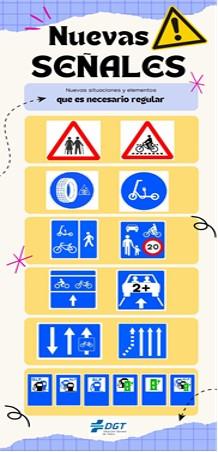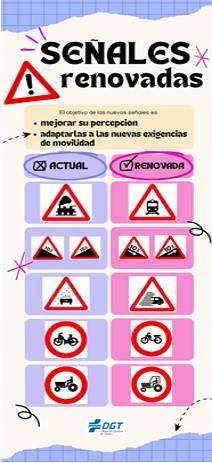The Spanish Government has approved the update of the official catalogue of traffic signs, adapting signage to social, technological, and mobility changes, with a unified catalogue that improves understanding and consistency throughout the country.
New signs are being added to regulate new modes of transportation, such as personal mobility vehicles, and to respond to current traffic situations.
Pictograms have been redesigned, visibility has been improved, and obsolete signs have been removed, with special attention to sustainability and inclusive visual language.
The royal decree will come into force on July 1, 2025, but the physical change of the signs will be carried out gradually.
The new signs will not be immediately included in the theoretical exams to allow time for updating the manuals and facilitating the preparation of candidates.
Contents
The Full Story
The Council of Ministers approved this Tuesday an amendment to the General Traffic Regulations that updates the road signage system, in force since 2003, with new traffic signs that reflect the social, technological, and mobility changes experienced over the last two decades and with the aim of improving road safety and efficient traffic management.
The reform of the General Traffic Regulations, carried out in collaboration with the Ministries of Transport and Sustainable Mobility, Industry and Tourism, and Defence, revises Title IV of the regulation, relating to vertical signage, construction and beaconing, traffic officer signage, circumstantial signage, and traffic lights, and consolidates an official catalogue of traffic signs and road markings that unifies the form, symbols, and nomenclature of all indicators.
Furthermore, given the growing volume of information received by drivers through multiple channels, the reform aims to ensure that the road signage system transmits clear, direct and universally understandable messages. To this end, beyond updating the design or graphic details of the signs, it ensures that the message received and interpreted by drivers, pedestrians and other users complies with the principles of an effective semiotic system in line with the provisions of the Vienna Convention on Road Signs and Signals. This update will therefore allow for better understanding by users and greater consistency throughout the country.
MAIN CHANGES
One of the priority objectives of the reform of the General Traffic Regulations is to adapt its content to current regulations and respond to the new needs arising from the advancement of mobility infrastructure and technologies. This update affects both the articles and Annex I and the official signage catalogues.
Among the main changes are the modification of the design and definition of numerous signage elements, including vertical signs, road markings, and a specific clarification of circumstantial signage. New signs are also being introduced to meet current demands, and those that have become obsolete or are no longer covered by recent regulations are being eliminated.
The amendments seek to align the regulations with the Traffic Law, improve the understanding and visibility of signs, modernise pictograms such as those for railways and bicycles, and better meet the needs of pedestrians and cyclists. Furthermore, sizes have been adjusted to promote more efficient and sustainable manufacturing, information at service stations has been expanded with new types of fuel, more detailed parking signs have been incorporated, and others have been modified due to the humanization work being carried out in numerous municipalities.
Another notable aspect is the elimination of gender connotations in the symbology, thus promoting a more inclusive visual language. This proposal improves the regulatory structure by reserving a brief mention of sign typology in the general articles and developing all the details on shape, colour, design, meaning, and dimensions in Annex I, along with the new catalogue, which visually and orderly compiles all vertical signs and road markings.
In addition, the Ministries of the Interior and Transport and Sustainable Mobility may, by joint ministerial order, modify, eliminate or incorporate new signs into the official catalogue, which will allow for a more agile and effective adaptation of the signage system to future needs.
New signs
The new catalogue of vertical signs incorporates a series of new indicators created to respond to the new realities and mobility needs posed by a constantly evolving society. The emergence of new modes of transportation, such as personal mobility vehicles, has generated situations that require specific regulations and clear, updated signage adapted to the current urban and road environment.
To create the various pictograms, the international use of signs with the same meaning was evaluated, as well as signs already in use in Spain.
The following infographic shows some of the new signs added to the Signs Catalogue.

Modified signs
The reform also includes those signs existing in the General Traffic Regulations that have undergone some type of modification in their design, code, or that have been eliminated to adapt the content of the aforementioned regulations to the proposed new catalogue.
The modification of these signs aims to improve their visibility and/or adapt them to new mobility requirements. Below are some of them:

PROGRESSIVE REPLACEMENT
The reform royal decree will enter into force on July 1, 2025, but the physical replacement of the signs will be carried out gradually and in coordination with the usual renewal cycles to reduce administrative burdens and optimize the use of public resources. Furthermore, the signs that have been removed must be removed for reasons of legal certainty within one year of the entry into force of the royal decree.
As is typical with any regulatory change, the new content will not be immediately incorporated into the theoretical tests for obtaining driving permits and licenses. After the regulation comes into effect, a minimum of three months will be allowed before its inclusion in the exams to allow for training manuals to be updated and ensure candidates have the necessary time to prepare adequately.
Discover more from N332.es - Driving In Spain
Subscribe to get the latest posts sent to your email.

You must be logged in to post a comment.